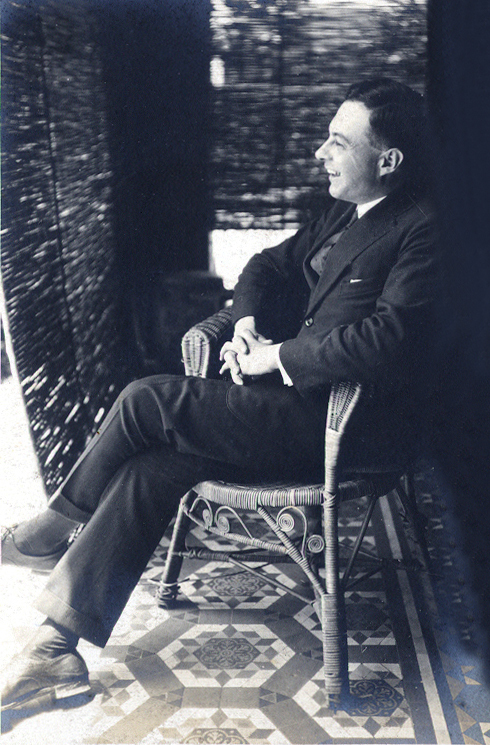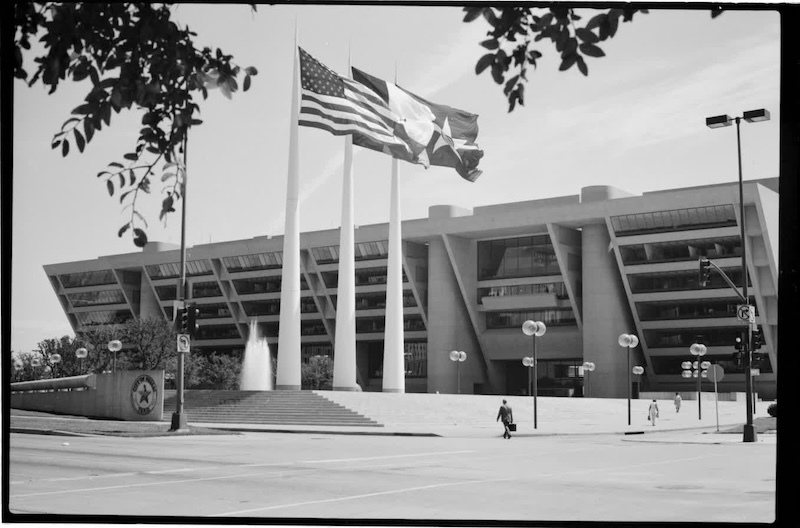
Wu Daqian was a prisoner of war who escaped from World War I. He created more than 100 individual buildings in Shanghai, 35 of which are still listed as Shanghai's outstanding historical buildings. He inspired the 80-year design dream of the architect I.M. Pei, but his career as a practicing architect lasted only more than 20 years. With his conscience and professionalism, he stuck to his certainty in the uncertain and chaotic world. More than 70 years after leaving Shanghai, he unexpectedly became an "Internet celebrity" and returned to the public eye. When young people clock in under the Wukang Building, they are touching a piece of history written by this foreign architect and Shanghai.

Wu Daqian in Shanghai (the photo is collected by Wu Daqian's grandson Irwin)
"He stayed in Shanghai for 29 years and had to leave. Few people knew him in the following decades. Faced with the great changes in the world at that time, he always adhered to his inner principles. Even in his most difficult times, when he was building the smallest house, he still adhered to the professional instincts and ethics of an architect; even when he could no longer build houses, he still made his own choices and judgments based on conscience rather than the drive of his position. These are what touched me." In an exclusive interview with a reporter from The Paper, Chen Qing, the director of the documentary "Hudec", talked about the origin of the production.
This documentary, produced by China Central News Documentary Film Studio (Group), took three years to shoot across Asia, Europe and America. Each episode is 30 minutes long. The film uses a rigorous and objective perspective to salvage the real footprints and spiritual heritage left by the Slovak-Hungarian architect in Shanghai. During this year's Shanghai TV Festival, the film also participated in offline screenings to communicate with the audience.

Documentary "Wudaqian" poster
In the 1990s, during a new round of urban construction in Shanghai, the home that Wu Daqian had carefully built was demolished, and today's Electric Power Hospital was built on the original site. The Wu Daqian Memorial Hall, which is only one kilometer away, was once Wu Daqian's largest home in Shanghai. The decoration and layout of the new house are more exquisite, with plenty of light and a tall fireplace. Chinese furniture and collections can be seen everywhere, showing the owner's China knowledge. The two wooden doors leading to the restaurant are carefully selected by Wu Daqian. Many years later, when he decided to leave Shanghai, these two doors also traveled across the ocean with him and walked halfway around the world.

Wu Daqian's former residence in Shanghai, now the Wu Daqian Memorial Hall (photo from the collection of Ivan)
In the film, Wu Daqian's grandson Irwin said: "They are very heavy, with three hinges to hold the doors in place, and they are very beautiful. These doors were later installed in the house designed by my father in Victoria, based on a beautiful sense of architectural design that he had formed in his childhood, from the buildings built by his father."

Interior view of Wu Daqian's former residence in Shanghai, with the door that followed him across half the world. (Photo from Irwin's collection)
The International Hotel, the "tallest building in the Far East" built in 1934, once served as Shanghai's "city skyline" for 50 years. The Grand Cinema was a renovation project taken over by Wu Daqian in 1930. It is also a model of "building a temple in a snail shell". Wu Daqian and his partners built the largest single cinema in the Far East on an irregular and cramped foundation. The green house, which was promised to be "not outdated for 100 years" when it was built, has witnessed the development and changes of Shanghai's urban planning for several times, and also witnessed the historical past of the perfect combination of modern architectural language and Chinese lifestyle.

Wu Daqian's sketch of the International Hotel (collected in the library of Victoria University, Canada)
Chen Qing believes that the documentary is not just about architecture, but "reconstructs how people of different ethnic groups and cultures in Shanghai, China, crossed the gap between the two world wars and achieved win-win results and created classics through the use of new technologies."
“I wanted to tell the story of his relationship to this era, this city and everyone today,” she said.
What impressed the reporter was that Chen Qing's team was very meticulous in digging up historical materials. For example, there were many versions of the correct translation of the name of "Kelly & Co." In Chen Qing's opinion, foreigners who wanted to develop in China at that time had to deal directly with customers, so he must have his own understanding and requirements for the translation of Chinese names.
Through understanding the history of the character, we found that RA Curry obtained a bachelor's degree in architecture from Cornell University in the United States in 1907. He was the first American to establish an architectural firm in Shanghai and was also Wu Daqian's first boss in Shanghai. He was not the "contractor" that Wu Daqian once complained about in his letters home. Chen Qing repeatedly emphasized to the team, "We must restore his true face as much as possible, so that we can really get close to the character and enter that era."
Later, the team saw in the Shanghai Urban Construction Archives that the letterhead printed by Carey & Co. was written with "Ke Li" on it, and finally there was no dispute. Chen Qing said, "This is just the smallest case, and everyone even thinks it is the least worthy of further investigation, but we have many such examples in the film."

Letterhead of Carey & Co. (collected in Shanghai Urban Construction Archives)
Wu Daqian constantly tried modern architectural practice, and he expressed his understanding of architecture in abstract lines. Whether it was the most underestimated Park Road Motor Vehicle Garage, the brewery on the Suzhou River, or the Zhenguang Building and Guangxue Building located in today's Bund Source, they all reflected his thoughts and emotions at different stages of his life.

Drawings of Wu Daqian’s first home in Shanghai (Collection of Victoria University Library, Canada)

Exterior photo of Wu Daqian's first home (now the Electric Power Hospital) (Collection of Victoria University Library, Canada)
In recent years, Wu Daqian has returned to the public eye. Hua Xiahong, the most important scholar in China who studies Wu Daqian, professor at the School of Urban and Planning of Tongji University, and one of the academic consultants of the documentary "Wudaqian", believes that the attention to Wu Daqian's architecture in recent years is due to many reasons. On the one hand, Wu Daqian left a lot of historical materials, and a large number of scholars internationally have conducted special research on Wu Daqian. In addition, this is closely related to the cultural exchanges between China and Central and Eastern European countries, especially Hungary and Slovakia, as well as the establishment of the Wu Daqian Memorial Hall in Shanghai. All these factors have jointly promoted the Wu Daqian fever in Shanghai.
As a researcher, she was happy but also worried, because Wu Daqian was only an outstanding example in the history of modern architecture in Shanghai. There are also a large number of outstanding Chinese and foreign architects, such as Gonghe Foreign Trade Co., Lai An Foreign Trade Co., Hongda Foreign Trade Co., Fan Wenzhao, Lu Qianshou, Li Jinpei, etc., who have jointly created the brilliant urban culture of Shanghai. She hopes that the Wu Daqian fever is the starting point of the public cultural fever with modern architecture as the entry point, rather than the end point. After the premiere of the documentary "Wudaqian", the exhibition "The World Connected by a Shanghai Architect" jointly organized by Tongji University and China Film Group Corporation focused on presenting the historical contributions of 17 contemporary Chinese and foreign architects, including Wu Daqian.
The documentary "Wudaqian" not only reveals the ups and downs of an architect's life and his professional persistence, but also shows how the city of Shanghai accommodated drifters in a special historical gap, and shaped its texture and soul through the collision of different cultures and ethnic groups and the tempering of professional spirit.

Chen Qing interviews Mr. Yan Erchun, a descendant of the "Green House"
【dialogue】
Seek truth and facts, all information cannot come from just one book
The Paper: Shooting historical documentaries is very difficult. How does the team ensure the authenticity and reliability of historical materials?
Chen Qing: History itself is a process of continuous discovery and interpretation. The academic basis of the film is the solid and systematic research on the history of modern architecture in Shanghai by several generations of scholars from Tongji University. It also benefits from the investigation and research from different angles by foreign scholars including Italy, Canada, Hungary, Slovakia and other countries.
When we make a documentary, we actually have a commitment to the audience in terms of creative ethics, that is, to its authenticity. Of course, due to the times, the creators' vision and ability, this authenticity is also relative. This is a film with a large span of time and space. The requirement I put forward to the entire team is that all the information cannot come from just one book. These materials must come from the archives we visited on the spot, and they must form mutual verification.

The team interviewed Professor Shi Xingyuan of the Department of Architecture at Budapest University of Technology and Economics
The Paper: What challenges did you encounter during your research? Were there any unexpected findings?
Chen Qing: I have been researching this topic since 2014. At that time, there were two difficulties. First, many experts, including our academic consultant Academician Zheng Shiling, Professor Wu Jiang, and Professor Hua Xiahong, focused their research on architecture rather than people. Second, although Wu Daqian became an "Internet celebrity", most of the narratives about the character himself had unclear sources, and most of them were even rumors.
After all, documentaries are about telling people's stories. We hope to present the story of Wu Daqian and the Shanghai people of that era, as well as the story between the architectural heritage he left behind and the Shanghai people of today. That is why we publicly solicited filming clues from Shanghai citizens at the opening ceremony.

Chen Qing (left) interviews and photographs Professor Wu Jiang, Chairman of the Asian Architects Association (right)
When we actually entered the archives in Hungary, Slovakia and Victoria, we had more breakthroughs and understanding. Our overseas shooting time was very limited, and many archives could not be interpreted in depth at the first time. These archives were mixed with Hungarian, English, German, Russian, Slovak, etc., and also included handwriting. What we can do is to take pictures of all the archives we can as soon as possible, and then slowly translate and interpret them after returning.
Of course, the value of some archives was realized the moment I saw them. For example, there have been various rumors about the history of Wu Daqian serving as the first Hungarian consul in Shanghai, but they were not clear. During the filming at the Hungarian National Archives, a letter with a Chinese seal caught my attention. The name on the seal was Yao Yongli. After careful reading, I found that this English letter was a reply from Chinese lawyer Yao Yongli accepting Wu Daqian's invitation to serve as the legal adviser of the Hungarian Consulate in Shanghai. Then I found a copy of the invitation letter that Wu Daqian had previously written to Yao Yongli, and clearly saw that the consulate at that time was opened in the office of Wu Daqian Foreign Trade Company on Yuanmingyuan Road. This discovery also further shows that Wu Daqian had a lot of exchanges with Chinese people at all levels at that time.

Documentary screenshots
After returning to China, we have been trying to find more information about lawyer Yao Yongli. It took a lot of effort, but finally, with the help of good friends, we found a photo of lawyer Yao Yongli in the relevant historical archives. It was just a very small photo, and it only appeared in the film for a few seconds. Probably no one would imagine the energy and effort the crew put in behind this small photo.
Standing at this historical node today, we have come across this topic and hope to piece together the historical fragments we can find as completely as possible. Of course, I believe that as time goes by and the archives are made public, more historical details will surely be discovered.
"In Shanghai, he can get respect"
The Paper: There is a character called Shao Qing, a real estate agent, in the film, and his perspective is very unique. Why did you introduce the perspective of this contemporary "stranger"?
Chen Qing: It was during the filming process that Shao Qing gradually mentioned that he was an outsider, which gave him the perspective of a contemporary "stranger" in the film. In fact, we initially pretended to rent or buy a house and contacted several old house agents because we wanted to know what the over-consumed Wu Daqian was like in their eyes. It was during the process of selling old houses that Shao Qing studied old houses and began to understand the history and culture of Shanghai. He gradually became interested and created a public account to spread the history and culture of Shanghai architecture. He seemed to see his own shadow in Wu Daqian, which touched us very much.
When we premiered the film at Xuhui Academy on Valentine's Day this year, I invited Shao Qing to attend the event. He didn't even dare to say that he was a new Shanghainese. He didn't have a Shanghai hukou, but he had lived in Shanghai for 10 to 20 years and loved the city very much. Not only Shao Qing, but also the painter Du Haijun and the director of the Wu Daqian Memorial Hall Liu Suhua in our film all mentioned their first arrival in Shanghai and their feelings for the city of Shanghai. I think this may be the charm of this city.
In the past, everyone thought that Shanghainese were xenophobic. In fact, through filming in Shanghai over the past few years, our team has gained a lot of support from organizations and individuals, and also made a lot of good friends. This makes me feel that Shanghai is very pragmatic. This city respects people who are professional and down-to-earth. This may be the reason why Wu Daqian was recognized. The city's inclusive and open character made Wu Daqian's architectural pursuits come true. It is worth mentioning that Wu Daqian's best houses were all built in cooperation with Chinese owners.
The Paper: Today we are going to discuss Wu Daqian, and our focus will be more on the spiritual power that a person’s professionalism can bring.
Chen Qing: That’s right. In Shanghai, he was able to gain respect, especially from Chinese owners and Chinese builders, and become close partners, precisely because of his professionalism. When reading the English newspapers of that year, Professor Qiao Zhengyue discovered that when Wu Daqian’s younger brother, Ge Zuo, died of illness in Shanghai, many of the people who came to mourn and send wreaths were his owners.
No one can succeed on their own. Wu Daqian’s architectural pursuit is modern, but his company’s management model is very traditional. He even does everything himself, and is very strict and serious about every architectural detail. We have seen that he once mentioned in a letter: "As a professional architect, I can't imagine using the client's money to complete a house that meets my architectural ideals."
Luca Pencellini, professor of the Department of Design and Applied Arts at the New Academy of Fine Arts in Milan, Italy, and author of the book "Hudec", told me in an interview, "You can use any architectural language to draw anything in any style. This is the education he (Hudec) received. In comparison, he is more like a tailor than an artist. He wants to say this is my style." When we interviewed and filmed at Hudec's alma mater, the Budapest University of Technology and Economics in Hungary, we could also understand more deeply the influence of the school's functional teaching tradition on Hudec. There is no doubt that Hudec has very strong professional ability and professionalism, and more importantly, he pays attention to people.

Wu Daqian at the construction site
In his early years, he wanted to be a pastor, but he became an architect in accordance with his father's request and the family's responsibility. In the words of his grandson Irwin, he is still "a soft-hearted person". He attaches importance to the users of buildings, and he tries to understand the needs of people of different races, identities and backgrounds, and tries to integrate these needs organically through architectural practice, and finally builds practical houses that can last for a hundred years.
The Paper: What was the biggest difficulty during the filming process?
Chen Qing: It took about six or seven years from the time I wanted to create this documentary to the time I actually got the funding to officially start filming. The pandemic hit right after the opening ceremony. Our team moved between Shanghai, Beijing, and any third location countless times. During the entire early filming process, because of the special period, no one was willing to open the door easily, and any interviews and filming were difficult. The Russian-Ukrainian conflict broke out, and our plans to go to Europe for filming were delayed again and again. Even before departure, flights were constantly adjusted.
Although there are many uncertainties, these uncertainties seem to be negligible compared with Wu Daqian's era and the difficulties he encountered.
Get to know this city from these houses
The Paper: After finishing the film, what do you think is Wu Daqian’s more important legacy to Shanghai today, apart from the architectural entities?
Chen Qing: In fact, the builders of the same generation as Wu Daqian and the first generation of Chinese architects are the groups we want to present in the film. Speaking of the first generation of architects, in addition to Liang Sicheng and Lin Huiyin, do the general public know more about them?
The three architects of Huagai Architectural Office, Zhao Shen, Chen Zhi and Tong Jun, who founded the firm in Shanghai in 1933, actually went to study architecture at the University of Pennsylvania in the United States at the same time as Liang Sicheng and Lin Huiyin. At that time, a group of people who studied architecture in top European and American universities returned to Shanghai to practice, and together with Western architects such as Wu Daqian, they shaped the appearance of this city, including Professor Wu Jiang's grandfather Wu Ziang.
Many of them stayed after the founding of New China and actively participated in national construction. The system of architectural design institutes after the founding of New China made architectural design a collective labor achievement. They participated in the design of many important buildings, including the top ten buildings in Beijing, but we often don't see their names. They were able to realize the importance of protecting historical buildings very early. As early as 1985, Chen Zhi, Feng Jizhong, Luo Xiaowei and other gentlemen began to call for the protection of modern historical buildings. In 1993, Shanghai announced the first batch of 61 outstanding historical buildings in Shanghai. Therefore, Shanghai is a city in China that started the protection of historical buildings earlier, and it is also a city that proposed "readable architecture" very early.
Over the past 30 years, Shanghai has announced five batches of 1,058 outstanding historical buildings. Among them, 35 are gifts left by Wu Daqian to the city. Of course, this number is constantly changing with the passage of time. It is not only Wu Daqian himself, but also a generation of Chinese and Western architects who are proficient in both Chinese and Western culture who have left this city with cultural heritage.
The Paper: The film chooses to "leave a window" at the end. What is the meaning of this "window"?
Chen Qing: 99% of Wu Daqian's architectural works are in Shanghai, China. The windows of various forms he left for Shanghai have become a window for people today to open up to the past century. In the process of our creation, we found that most people who are interested in Wu Daqian or old architectural history and culture enthusiasts are people who cherish the history and culture of their own city and are curious and exploratory about the way we came and went. In addition, these old houses are indeed filled with the memories of generations.
What's gratifying is that many young people are interested in it. When we screened the documentary at Xuhui Academy, some children born in the 2000s and 2010s interacted with me and said they liked the documentary very much. I think they can see the history and texture of the city through this film and understand why the city has become what it is today. When young people check in under the Wukang Building, they are touching a piece of history written by strangers and a city.

Chen Qing's family cemetery in Banská Hudec, Slovakia


